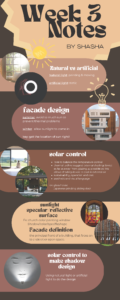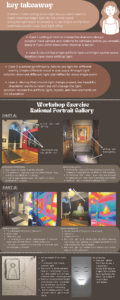Week 3 Lecture notes + workshop exercise
This is my Week 3 lecture notes update is the pdf document, a clear version of my notes.


Down below is the website link you can watch the two image more clearly.
My reflection and additional research on Week 3:
I want to focus on my research about the benefits of natural light for interiors and people, and how to make good use of it.
Difference between natural light and artificial light:
- Natural light and artificial light differ in their source and characteristics. Natural light comes from the sun and varies throughout the day and across seasons, while artificial light is created by human-made sources like light bulbs and LEDs.
- Natural light has several benefits for indoor spaces, including providing a higher quality of light, improving mood and productivity, and reducing energy costs. However, excessive sunlight can also cause problems such as overheating, glare, and fading of interior finishes and furniture.
Here are some examples of how people can use natural light as an important source of light and heat for indoor spaces while avoiding excessive heat gain:
- Orientation: Orienting a building or room to maximize natural light can help reduce the need for artificial lighting and heating. South-facing windows receive the most sunlight, so placing rooms or buildings to take advantage of this orientation can help maximize natural light and heat gain.
- Shading: Using shading devices like curtains, blinds, or shades can help regulate the amount of sunlight entering a space and prevent overheating. Exterior shading devices like overhangs and awnings can also help reduce heat gain by blocking direct sunlight.
- Glazing: Using high-performance glazing materials like Low-E glass or spectrally selective coatings can help reduce heat gain while allowing natural light to enter a space. These materials can selectively filter out certain wavelengths of light, reducing the amount of solar radiation that enters a space.
- Light shelves: Light shelves are horizontal surfaces that reflect natural light onto the ceiling, helping to diffuse the light and reduce glare while increasing natural light levels deeper into the room.
Some benefits that natural light brings to humans:
- Improves mood: Exposure to natural light has been shown to improve mood and reduce symptoms of depression and anxiety.
- Enhances sleep quality: Exposure to natural light during the day helps regulate the body’s natural sleep-wake cycle, leading to better sleep quality at night.
- Increases productivity: Studies have found that natural light in the workplace can lead to higher productivity, fewer errors, and reduced absenteeism.
- Improves visual acuity: Natural light provides a higher quality of light than artificial sources, leading to better visual acuity and reducing eye strain and fatigue.
- Reduces energy costs: Maximizing natural light in buildings can reduce the need for artificial lighting and heating, leading to lower energy costs and a smaller carbon footprint
Reference:
Peña-García, A., Molina-García, A., & García-Moreno, P. J. (2018). Natural Light in Architecture: Design Strategies for Sustainable and Healthy Buildings. Energies, 11(12), 3407.
Zuo, W., & Ong, S. K. (2016). Daylighting and thermal performance of a sustainable building: A case study in Singapore. Building and Environment, 106, 54-63.
Thank you for watching my Week 3 posts.




Recent comments